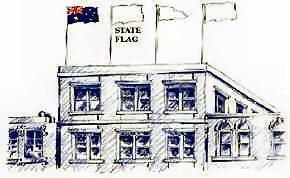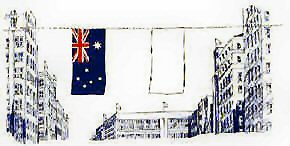Email Us: admin@australianflag.biz
Showroom: 218 Gladstone St, Fyshwick, ACT
Order Online We deliver Australia & worldwide
Email Us: admin@australianflag.biz
Showroom: 218 Gladstone St, Fyshwick, ACT
Order Online We deliver world wide
Flag Etiquette for the Australian National Flag
By courtesy of diggerhistory.info
Respect It, Display It, and Treat It With Care
It is the universal custom to display the national flag from sunrise to sunset on buildings and on stationary flagstaffs in the open on all days that weather permits, but especially on national and state holidays and other days that may be proclaimed by the Government.
When the Australian National Flag is flown alone on top of, or in front of a building where there are two flagpoles, it should be flown on the flagpole to the left of the observer facing the flag.
When the Australian National Flag is flown alone on top of, or in front of, a building where there are more than two flagpoles, it should be flown as near as possible to the centre.
The Australian National Flag may be displayed 24 hours a day if properly illuminated during hours of darkness.
Always hoist the Australian National Flag briskly. Lower it ceremoniously.
If carried with other flags, in a single file, the Australian National Flag should always lead.
SALUTING THE FLAG: When a national flag is raised or lowered as part of a ceremony, or when it passes by in a parade or in review, all persons, except those in uniform, should face the flag and stand at attention with (optionally) the right hand over the heart.
When not in uniform, a man should remove his hat with his right hand and hold it at the left shoulder, the hand being over the heart. Those in uniform should give the military salute. The flag should be saluted at the moment it passes in a parade or in review. Citizens of other countries stand at attention, but need not salute.
When displayed from a staff in a church or public auditorium, the flag of Australia should be in the position of honour at the clergyman's or speaker's right as he faces the audience (the left of the audience). Any other flag so displayed is to be placed to the speaker's left as he faces the audience (the right of the audience).
If displayed flat against a wall on a speaker's platform, the Australian National Flag should be placed above and behind the speaker, with the union on the left hand side as the audience sees it.
Note the correct way of hanging the flag vertically.
The Australian National Flag should be at the centre and at the highest point of the group when a number of flags of States or localities or pennants of societies are grouped and displayed from staffs.
When the Australian National Flag is on display with flags of other nations, all staffs should be of equal height with the Australian National Flag in the position of honour at the Australian flag's own right, which is the extreme left as the flags are viewed.
When displayed outdoors with other flags, the position of honour for the Australian National Flag is normally the extreme left position as the flags are most frequently viewed, except in a line of flags representing a number of sovereign nations, where there are three or more making an odd number of flags, the Australian National Flag should be flown in the centre. The Australian National Flag should be flown at BOTH ends if 2 flags are available regardless of overall number of flags.




The Australian National Flag when displayed with another flag against a wall from crossed staffs, should be on the Australian flag's own right, (left side as seen by audience) and its staff should be in front of the staff of the other flag.
When the Australian National Flag is displayed on a pole projecting from a building, the union of the flag should be placed at the peak of the staff unless the flag is at half staff (half mast). When suspended from a rope extending from the building on a pole, the flag should be hoisted out union first from the building. 


When the National Flag is displayed on, or in front of, a building with Australian State or house flags the Australian National Flag should be flown on the left of a person facing the flags, or at each end on a line of flags.
When displayed with State flags, house flags and club pennants on a flagpole fitted with a yardarm, the Australian National Flag should be flown above and in the centre.
When displayed on a flagpole fitted with a yardarm with a flag of a sovereign nation or a State flag, the Australian National Flag is displayed as follows:


If the flagpole is fitted with a gaff the flag on the gaff has the position of honour, although the national flag is then lower than another flag flying from the peak. This tradition originated in the days of sailing ships and was designed to keep the flag from the ship's rigging.
When flags of two or more nations are displayed: In this circumstance, all the flags including the Australian National Flag are to be flown from separate staffs of the same height. The flags should be of approximately equal size. International usage forbids the display of one nation's flag above that of another nation's in time of peace.
Other flags should not be flown from the same halyard.
When other flags are flown from adjacent staffs, the Australian National Flag should be hoisted first and lowered last. No flag may fly above or to the right of the Australian flag.

If carried in line abreast, it is preferable to have the Australian National Flag at each end of the line. 
If only one Australian National Flag is available, it should be placed in the centre of the line of flags carried abreast in a line made up of an uneven number of flags. 
Where the number of flags is even and the Australian National Flag cannot be carried in the centre (of a line of flags abreast) it should be placed (carried) on the right-hand end of the line facing the direction of movement.
When suspended vertically in the middle of a street the top left quarter should face the north in an east-west street, and face east in a north-south street, thus being on the left of the observer facing east or south respectively. 

In a semi-circle of flags representing a number of sovereign nations, the Australian Flag should be in the centre. In an enclosed circle of flags representing a number of sovereign nations, the Australian National Flag should be flown on the flagpole immediately opposite the main entrance to a building or arena.


When flown at half staff (half mast), the Australian National Flag should be first hoisted to the peak for a moment and then lowered to the half staff (half mast) position.
The flag should be again raised to the peak before it is lowered for the day.
When the Australian National Flag is used to cover a casket, it should be so placed that the union is at the head and over the left shoulder.
The flag should not be lowered into the grave or allowed to touch the ground.


 Flags
Flags 